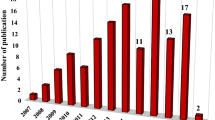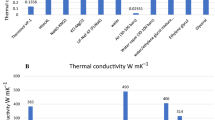Abstract
Nanofluids can be utilized as efficient heat transfer fluids in many thermal energy systems to improve the system’s thermal efficiency. This survey reviews and summarizes the experimental and numerical studies performed to determine the effect of nanofluids on the performance of condensing and evaporating systems. Advantages and disadvantages of nanofluid implementation in condensing and evaporating systems are evaluated and summarized. Moreover, some suggestions and recommendations are presented for future studies. This review shows that the nanoparticle deposition and nanoparticle suspension are two important factors affecting the thermal system’s efficiency. These factors should be considered when using different nanofluids in condensing and evaporating systems.







Similar content being viewed by others
References
Laohalertdecha S, Kaew-On J, Wongwises S. The effect of the electrohydrodynamic on the two-phase flow pressure drop of R-134a during evaporation inside horizontal smooth and micro-fin tubes. Heat Transf Eng. 2010;31:108–18.
Sohag FA, Becka FR, Mohanta L, Cheung FB, Segall AE, Eden TJ, Potter JK. Enhancement of downward-facing saturated boiling heat transfer by the cold spray technique. Nucl Eng Technol. 2017;49:113–22.
Boziuk TR, Smith MK, Glezer A. Enhanced boiling heat transfer on plain and featured surfaces using acoustic actuation. Int J Heat Mass Transf. 2017;108:181–90.
He Y, Li H, Hu Y, Wang X, Zhu J. Boiling heat transfer characteristics of ethylene glycol and water mixture based ZnO nanofluids in a cylindrical vessel. Int J Heat Mass Transf. 2016;98:611–5.
Kim DE, Yu DI, Jerng DW, Kim MH, Ahn HS. Review of boiling heat transfer enhancement on micro/nanostructured surfaces. Exp Therm Fluid Sci. 2015;66:173–96.
Mori S, Utaka Y. Critical heat flux enhancement by surface modification in a saturated pool boiling: a review. Int J Heat Mass Transf. 2017;108:2534–57.
Famileh IZ, Esfahani JA. Experimental investigation of wet flue gas condensation using twisted tape insert. Int J Heat Mass Transf. 2017;108:1466–80.
Fang X, Chen Y, Zhang H, Chen W, Dong A, Wang R. Heat transfer and critical heat flux of nanofluid boiling: a comprehensive review. Renew Sustain Energy Rev. 2016;62:924–40.
Ciloglu D, Bolukbasi A. A comprehensive review on pool boiling of nanofluids. Appl Therm Eng. 2015;84:45–63.
Kamatchi R, Venkatachalapathy S. Parametric study of pool boiling heat transfer with nanofluids for the enhancement of critical heat flux: a review. Int J Therm Sci. 2015;87:228–40.
Celen A, Çebi A, Aktas M, Mahian O, Dalkilic AS, Wongwises S. A review of nanorefrigerants: flow characteristics and applications. Int J Refrig. 2014;44:125–40.
Cai J, Hu X, Xiao B, Zhou Y, Wei W. Recent developments on fractal-based approaches to nanofluids and nanoparticle aggregation. Int J Heat Mass Transf. 2017;105:623–37.
Bashirnezhad K, Rashidi MM, Yang Z, Bazri S, Yan WM. A comprehensive review of last experimental studies on thermal conductivity of nanofluids. J Therm Anal Calorim. 2015;122:863–84.
Fieg GP, Roetzel W. Calculation of laminar film condensation in/on inclined elliptical tubes. Int J Heat Mass Transf. 1994;37:619–24.
Capellas M, Caminal G, Gonzalez G, Lopez-Santin J, Clapes P. Enzymatic condensation of cholecystokinin CCK-8 (4–6) and CCK-8 (7–8) peptide fragments in organic media. Biotechnol Bioeng. 1997;56:456–63.
Sun DW, Zheng L. Vacuum cooling technology for the agri-food industry: past, present and future. J Food Eng. 2006;77:203–14.
Dutta A, Som SK, Das PK. Film condensation of saturated vapour over horizontal non-circular tubes with progressively increasing radius of curvature drawn in the direction of gravity. ASME J Heat Transf. 2004;126:906–14.
Dalkilic AS, Wongwises S. Intensive literature review of condensation inside smooth and enhanced tubes. Int J Heat Mass Transf. 2009;52:3409–26.
Liu ZH, Li YY, Bao R. Thermal performance of inclined grooved heat pipes using nanofluids. Int J Therm Sci. 2010;49:1680–7.
Huminic G, Huminic A. Heat transfer characteristics of a two-phase closed thermosyphons using nanofluids. Exp Therm Fluid Sci. 2011;35:550–7.
Reis Parise JA. A simulation model for the application of nanofluids as condenser coolants in vapor compression heat pumps. In: International refrigeration and air conditioning conference, 2012, Purdue University.
Huminic G, Huminic A. Numerical study on heat transfer characteristics of thermosyphon heat pipes using nanofluids. Energy Convers Manag. 2013;76:393–9.
Avramenko AA, Shevchuk IV, Tyrinov AI, Blinov DG. Heat transfer at film condensation of stationary vapor with nanoparticles near a vertical plate. Appl Therm Eng. 2014;73:389–96.
Avramenko AA, Shevchuk IV, Tyrinov AI, Blinov DG. Heat transfer at film condensation of moving vapor with nanoparticles over a flat surface. Int J Heat Mass Transf. 2015;82:316–24.
El Mghari H, Louahlia-Gualous H, Lepinasse E. Numerical study of nanofluid condensation heat transfer in a square microchannel. Numer Heat Transf Part A Appl. 2015;68:1242–65.
Turkyilmazoglu M. Analytical solutions of single and multi-phase models for the condensation of nanofluid film flow and heat transfer. Eur J Mech B Fluids. 2015;53:272–7.
Turkyilmazoglu M. Condensation of laminar film over curved vertical walls using single and two-phase nanofluid models. Eur J Mech B Fluids. 2017;65:184–91.
Malvandi A, Ghasemi A, Ganji DD, Pop I. Effects of nanoparticles migration on heat transfer enhancement at film condensation of nanofluids over a vertical cylinder. Adv Powder Technol. 2016;27:1941–8.
Malvandi A, Ganji DD, Kaffash MH. Magnetic field effects on nanoparticle migration and heat transfer of alumina/water nanofluid in a parallel-plate channel with asymmetric heating. Eur Phys J Plus. 2015;130:63.
Moshizi SA, Malvandi A. Different modes of nanoparticle migration at mixed convection of Al2O3–water nanofluid inside a vertical microannulus in the presence of heat generation/absorption. J Therm Anal Calorim. 2016;126:1947–62.
Malvandi A, Ganji DD, Pop I. Laminar filmwise condensation of nanofluids over a vertical plate considering nanoparticles migration. Appl Therm Eng. 2016;100:979–86.
Malvandi A, Heysiattalab S, Ganji DD. Effects of magnetic field strength and direction on anisotropic thermal conductivity of ferrofluids (magnetic nanofluids) at filmwise condensation over a vertical cylinder. Adv Powder Technol. 2016;27:1539–46.
Heysiattalab S, Malvandi A, Ganji DD. Anisotropic behavior of magnetic nanofluids (MNFs) at filmwise condensation over a vertical plate in presence of a uniform variable-directional magnetic field. J Mol Liq. 2016;219:875–82.
Lee YA, Kuo LS, Su TW, Hsu CC, Chen PH. Orientation effects of nanoparticle-modified surfaces with interlaced wettability on condensation heat transfer. Appl Therm Eng. 2016;98:1054–60.
Famileh IZ, Esfahani JA, Vafai K. Effect of nanoparticles on condensation of humid air in vertical channels. Int J Therm Sci. 2017;112:470–83.
Chon CH, Paik S, Tipton JB, Kihm KD. Effect of nanoparticle sizes and number densities on the evaporation and dryout characteristics for strongly pinned nanofluid droplets. Langmuir. 2007;23:2953–60.
Sefiane K, Bennacer R. Nanofluids droplets evaporation kinetics and wetting dynamics on rough heated substrates. Adv Colloid Interface Sci. 2009;147–148:263–71.
Chen RH, Phuoc TX, Martello D. Effects of nanoparticles on nanofluid droplet evaporation. Int J Heat Mass Transf. 2010;53:3677–82.
Chen RH, Phuoc TX, Martello D. Surface tension of evaporating nanofluid droplets. Int J Heat Mass Transf. 2011;54:2459–66.
Zhao IJ, Wang XD, Duan YY, Wang BX. Effect of nanofluids on thin film evaporation in microchannels. J Nanopart Res. 2011;13:5033–47.
Gan Y, Qiao L. Evaporation characteristics of fuel droplets with the addition of nanoparticles under natural and forced convections. Int J Heat Mass Transf. 2011;54:4913–22.
Javed I, Baek SW, Waheed K. An experimental investigation on effects of an electric field on bubble growth on a small heater in pool boiling. Combust Flame. 2013;160:170–83.
Gerken WJ, Thomas AV, Koratkar N, Oehlschlaeger MA. Nanofluid pendant droplet evaporation: experiments and modeling. Int J Heat Mass Transf. 2014;74:263–8.
Shin DH, Choi CK, Kang YT, Lee SH. Local aggregation characteristics of a nanofluid droplet during evaporation. Int J Heat Mass Transf. 2014;72:336–44.
Tso CY, Chao YH. Study of enthalpy of evaporation, saturated vapor pressure and evaporation rate of aqueous nanofluids. Int J Heat Mass Transf. 2015;84:931–41.
Chen W, Lin J. Thermal analysis of nanofluids on the thin film evaporation of meniscus. Heat Transf Asian Res. 2016;45:578–93.
Rudolf Eggers J, Matthias Lange E, Kabelac S. Particle migration in isobaric and flash evaporation of nanofluids. Forsch Ingenieurwes. 2016;80:101–9.
Wei Y, Deng W, Chen RH. Effects of insoluble nano-particles on nanofluid droplet evaporation. Int J Heat Mass Transf. 2016;97:725–34.
Wei Y, Deng W, Chen RH. Effects of internal circulation and particle mobility during nanofluid droplet evaporation. Int J Heat Mass Transf. 2016;103:1335–47.
Fu S, Tso C, Fong Y, Chao CYH. Evaporation of Al2O3-water nanofluids in an externally micro-grooved evaporator. Sci Technol Built Environ. 2016;23:345–54.
Mahian O, Kianifar A, Zeinali Heris S, Wen D, Sahin AZ, Wongwises S. Nanofluids effects on the evaporation rate in a solar still equipped with a heat exchanger. Nano Energy. 2017;36:134–55.
Wang GS, Song B, Liu ZH. Operation characteristics of cylindrical miniature grooved heat pipe using aqueous CuO nanofluids. Exp Therm Fluid Sci. 2010;34:1415–21.
Chiang Y, Kuo W, Ho C, Chieh J. Experimental study on thermal performances of heat pipes for air-conditioning systems influenced by magnetic nanofluids, external fields, and micro wicks. Int J Refrig. 2014;43:62–70.
Liu Z, Li Y, Bao R. Compositive effect of nanoparticle parameter on thermal performance of cylindrical microgrooved heat pipe using nanofluids. Int J Therm Sci. 2011;50:558–68.
Do KH, Jang SP. ‘‘Effect of nanofluids on the thermal performance of a flat micro heat pipe with a rectangular grooved wick. Int J Heat Mass Transf. 2010;53:2183–92.
Mehrali M, Sadeghinezhad E, Azizian R, Reza A, Tahan S, Mehrali M, Simon H, Metselaar C. Effect of nitrogen-doped graphene nanofluid on the thermal performance of the grooved copper heat pipe. Energy Convers Manag. 2016;118:459–73.
Kole M, Dey TK. Thermal performance of screen mesh wick heat pipes using water-based copper nanofluids. Appl Therm Eng. 2013;50:763–70.
Do KH, Ha HJ, Jang SP. Thermal resistance of screen mesh wick heat pipes using the water-based Al2O3 nanofluids. Int J Heat Mass Transf. 2010;53:5888–94.
Putra N, Septiadi WN, Rahman H, Irwansyah R. Thermal performance of screen mesh wick heat pipes with nanofluids. Exp Therm Fluid Sci. 2012;40:10–7.
Peng H, Ding G, Hu H. Effect of surfactant additives on nucleate pool boiling heat transfer of refrigerant-based nanofluid. Exp Therm Fluid Sci. 2011;35:960–70.
Peng H, Ding G, Hu H. Influences of refrigerant-based nanofluid composition and heating condition on the migration of nanoparticles during pool boiling. Part I: experimental measurement. Int J Refrig. 2011;34:1823–32.
Peng H, Ding G, Hu H. Influences of refrigerant-based nanofluid composition and heating condition on the migration of nanoparticles during pool boiling. Part II: model development and validation. Int J Refrig. 2011;34:1833–45.
Peng H, Ding G, Hu H, Jiang W. Effect of nanoparticle size on nucleate pool boiling heat transfer of refrigerant-oil mixture with nanoparticles. Int J Heat Mass Transf. 2011;54:1839–50.
Prakash NG, Anoop KB, Das SK. Mechanism of enhancement/deterioration of boiling heat transfer using stable nanoparticles suspensions over vertical tubes. J Appl Phys. 2007;102:1–7.
Prakash NG, Anoop KB, Sateesh G, Das SK. Effect of surface orientation on pool boiling heat transfer of nanoparticle suspensions. Int J Multiph Flow. 2008;34:145–60.
Zheng R, Gao J, Wang J, Chen G. Reversible temperature regulation of electrical and thermal conductivity using liquid–solid phase transitions. Nat Commun. 2011;2:289.
Hsieh SS, Liu HH, Yeh YF. Nanofluids spray heat transfer enhancement. Int J Heat Mass Transf. 2016;94:104–18.
Author information
Authors and Affiliations
Corresponding author
Rights and permissions
About this article
Cite this article
Rashidi, S., Mahian, O. & Languri, E.M. Applications of nanofluids in condensing and evaporating systems. J Therm Anal Calorim 131, 2027–2039 (2018). https://doi.org/10.1007/s10973-017-6773-7
Received:
Accepted:
Published:
Issue Date:
DOI: https://doi.org/10.1007/s10973-017-6773-7




